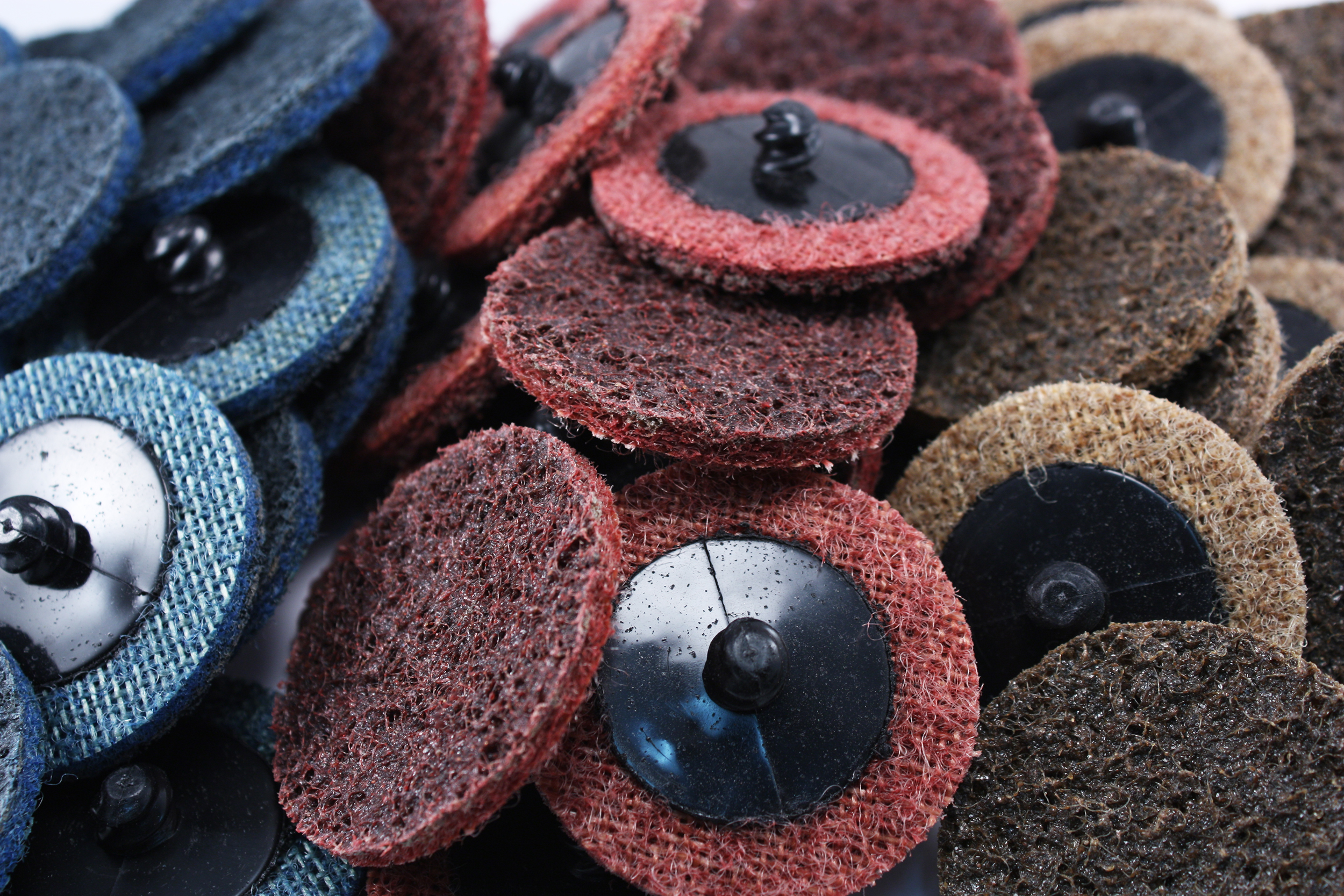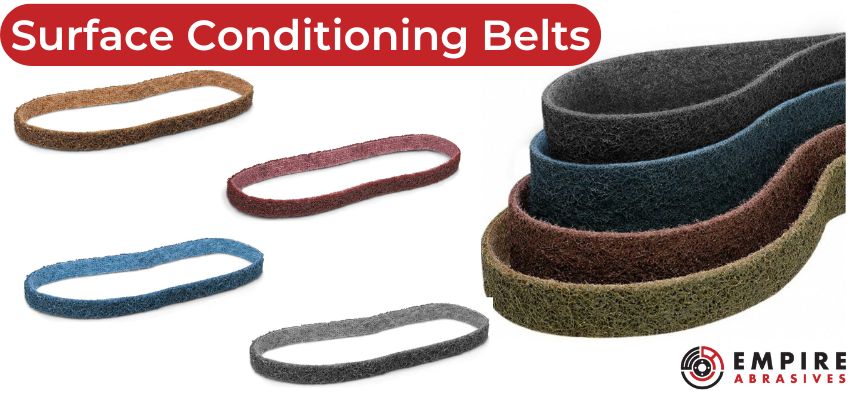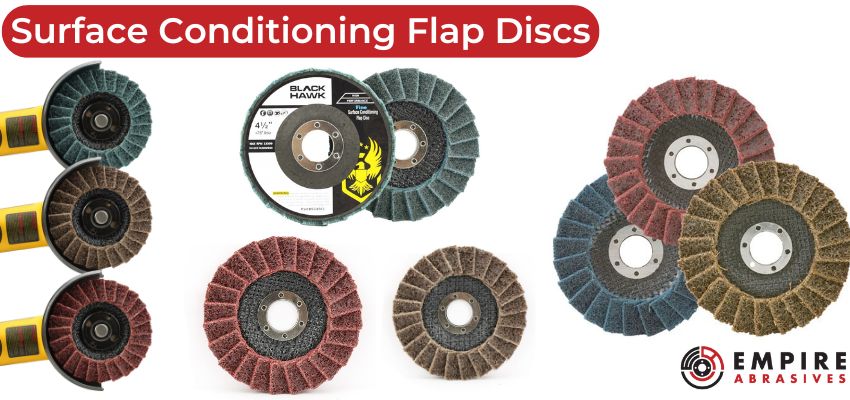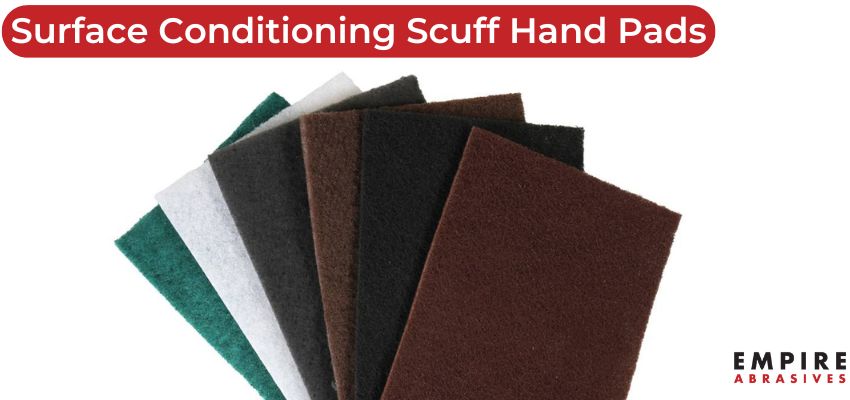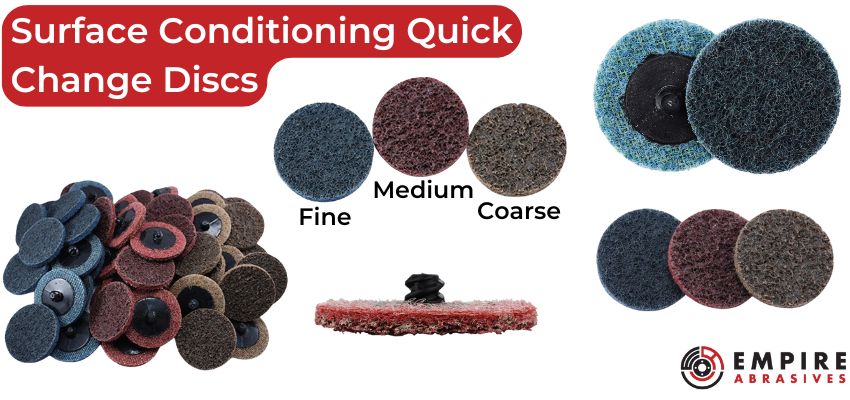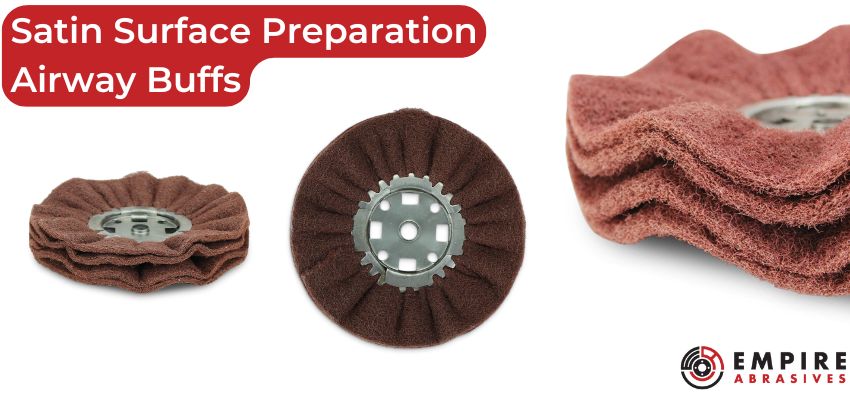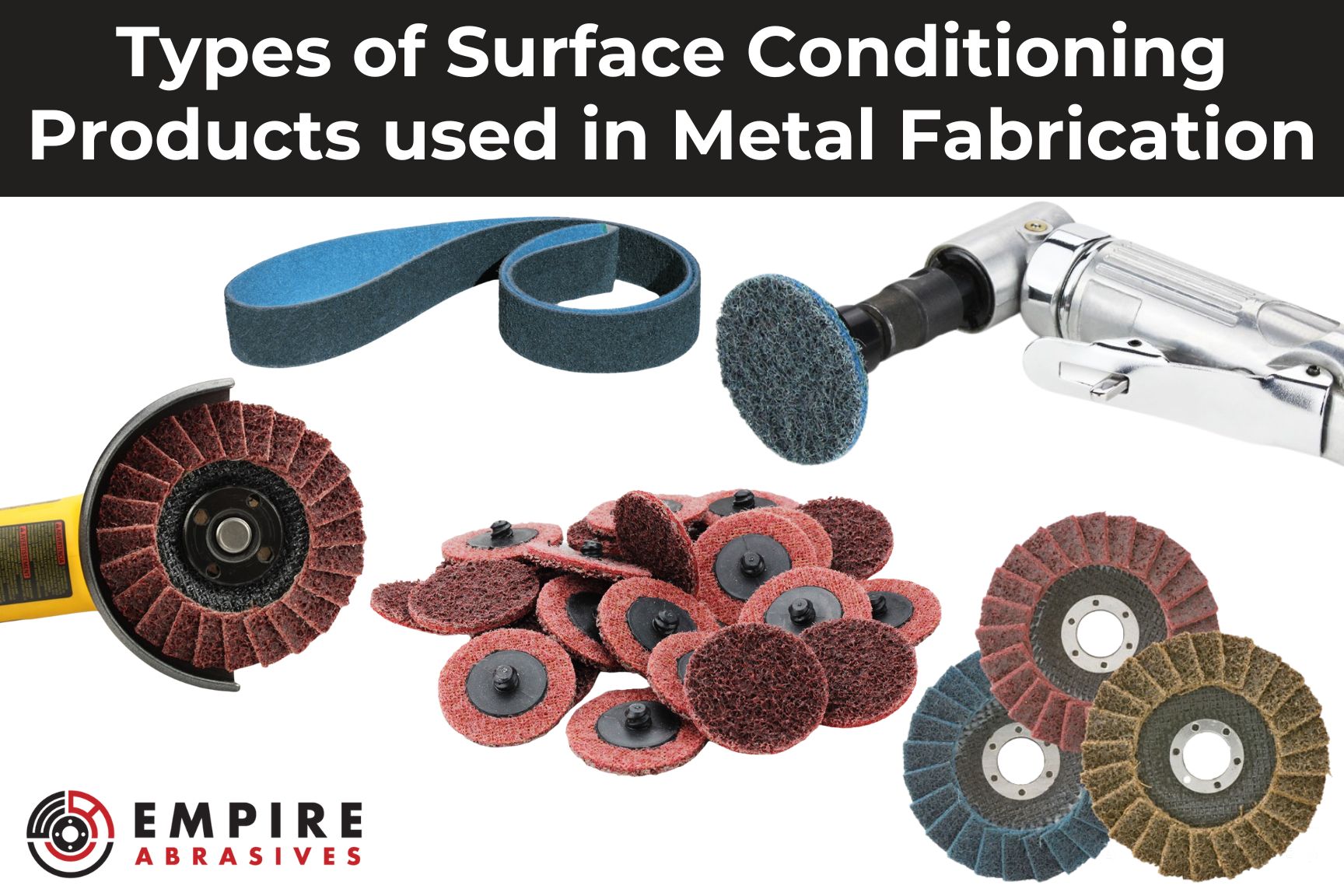 In the world of metal fabrication, achieving a high-quality finish is just as important as the initial design and construction. Surface conditioning plays a crucial role in enhancing the aesthetics, durability, and functionality of metal products. Whether you're looking to remove imperfections, prepare surfaces for painting, or achieve a mirror-like finish, the right surface conditioning products can make all the difference. In this comprehensive guide, we'll delve into what materials make up surface conditioning products, how they're used, and the various types available to help you select the best products for your projects.
In the world of metal fabrication, achieving a high-quality finish is just as important as the initial design and construction. Surface conditioning plays a crucial role in enhancing the aesthetics, durability, and functionality of metal products. Whether you're looking to remove imperfections, prepare surfaces for painting, or achieve a mirror-like finish, the right surface conditioning products can make all the difference. In this comprehensive guide, we'll delve into what materials make up surface conditioning products, how they're used, and the various types available to help you select the best products for your projects.
Explore our full range of surface conditioning products to find the perfect tool for your next project.
What Is Surface Conditioning Material?
Surface conditioning material is a type of durable non-woven abrasive made from a polymer with a nylon cloth backing. It's most commonly known by the brand name Scotch-Brite™. Unlike the scouring pads you might use at home, industrial-grade surface conditioning materials are infused with abrasive grains such as aluminum oxide, zirconia, ceramic, and titanium oxide. This combination creates an abrasive that is strong enough to scratch glass and is essential in various metalworking applications.
Although the polymers may be considered "soft," their composition with abrasive grains allows them to effectively remove material without damaging or significantly changing the shape or dimension of the workpiece. These materials are specially formulated to resist loading and extend the life of the disc, belt, or pad.
What Is Surface Conditioning Material Used For?
Surface conditioning material aka Scotch-Brite™ is used for a lot of applications such as blending, cleaning, deburring, finishing, linishing, and polishing. Using surface conditioning (Scotch-Brite™) pads, wheels, or belts allow you to end up with a very smooth surface with a uniform finish with a lot less work involved. The open structure of the non-woven polymer prevents heat buildup and discoloration as well as resists loads and avoids gouging or undercutting the work piece. In simplest terms it is used to change the patina of a metal surface. You can create a brush or mirror finish to metals such as stainless steel.
Types of Surface Conditioning Products
Surface Conditioning Belts
Surface conditioning belts are incredibly versatile and a staple in any metalworker's toolkit. These belts are made from the same durable, non-woven surface conditioning material we've discussed, but in a belt form that can be used on bench or handheld belt sanders and linishing machines.
Applications:
- Blending and Finishing: Ideal for smoothing out surfaces and blending imperfections.
- Linishing: Perfect for refining the flatness of surfaces using belt sanding techniques.
- Polishing: Helps achieve various finishes, from a brushed look to a mirror-like shine.
Popular Sizes Include:
- ½” x 18”
- 1” x 30”
- 1 ½” x 30”
- 1” x 42”
- 2” x 36”
- 2” x 48”
- 2” x 72”
- 4” x 36”
- 6” x 48”
Usage Tips:
- Progress Through Grits: Start with the coarsest grit needed for your application and work your way to finer grits for the best results.
- Consistent Pressure: Apply light to moderate pressure; let the belt do the work to prevent overheating and extend the belt's life.
- Tool Compatibility: Ensure the belt size matches your sander or linishing machine for optimal performance.
Why Use Surface Conditioning Belts?
These belts are often referred to as "a knife maker's secret weapon" because of their ability to produce a sharp, polished edge without overheating the metal, which can affect its temper. They're also excellent for metalworkers who need to maintain tight tolerances, as they remove material without significantly altering the workpiece's dimensions.
Looking for the perfect belt for your project? Browse our wide selection of surface conditioning belts, available in various sizes and grits.
Surface Conditioning Flap Discs
A surface conditioning flap disc combines the reliability and versatility of a flap disc for metal with surface conditioning capabilities. They're made from premium, heavy-duty, non-woven surface conditioning material adhered in an overlapping flap pattern onto a strong fiberglass backing. This design allows you to drastically decrease the time spent on finishing or polishing your project.
These surface conditioning flap discs are typically available in 4-½” x ⅞” Tan (Coarse), Red/Maroon (Medium), and Fine (Blue). They can be attached right to an angle grinder without the need of any backing pad and are a T29 (conical) shape for optimal surface contact during use.
Benefits Include:
- Self-Renewing Properties: As the nylon material wears down, it exposes new material beneath, providing consistent results throughout the disc's life.
- Longer Lifespan: The flap disc construction extends the life of the disc compared to traditional options.
- Increased Efficiency: Less downtime since you won't need to constantly change discs.
Ready to save time on finishing tasks? Shop our premium surface conditioning flap discs now.
Surface Conditioning Hand Pads
The non-woven surface conditioning hand pads, also known as Scotch-Brite™ pads, are a great tool to have in your arsenal as they will never rust and are an excellent alternative to steel wool, wire brushes, sandpaper, and other products for cleaning or finishing tasks by hand.
These surface conditioning hand pads come in various colors that denote grain and usage:
- White is a non-abrasive and is primarily used for cleaning.
- Grey is ultra fine and a grit range of 800-1000.
- Maroon is for general purpose and has a grit range of 360-400.
- Green is generally used for industrial scouring and has a grit of 240.
- Black is commonly used for stainless steel and has a grit of 150.
- Tan is the coarsest grit of 120 and used for heavy duty applications primarily.
Usage Tips:
- Use wet or dry; they can be rinsed clean for reuse.
- Ideal for blending, cleaning, polishing on metals, plastics, ceramics, and more.
- Store grey and black pads separately and label them, as the colors can look very similar.
How Long Do the Surface Conditioning Hand Pads Last?
Surface conditioning hand pads are specially designed to offer both flexibility and comfortability for an abrasive. They have been designed to be used with water or solvents and will rinse clean for reuse. This design has been optimized for the longest lasting scotch brite material on the market. They don’t shred during use nor do they leave fine metal splinters. The hand pads are also resistant to tearing and shredding.
Find the right hand pad for your application. Check out our premium surface conditioning scuff hand pads today.
Surface Conditioning Hook and Loop Discs
Similar to how Scotch-Brite™ is a registered trademark for surface conditioning, hook and loop is another name for Velcro. The hook and loop surface conditioning discs attach to a backing pad or to a hook and loop machine and offer the same functionality and versatility as the surface conditioning flap discs.
Benefits Include:
- Flexibility: Allows them to conform to irregular or contoured surfaces.
- Heat Dissipation: The porous nature of the material allows airflow during use, preventing heat buildup.
- Versatility: Suitable for polishing, grinding, finishing, blending, and deburring, especially on heat-sensitive metals.
Available Sizes and grits:
- 5" Surface Conditioning Hook and Loop Discs
- 7" discs Surface Conditioning Hook and Loop Discs
- Available in coarse (tan), medium (maroon), and fine (blue) grits.
Usage Tips:
- Attach securely to a backing pad.
- Use appropriate speed settings to prevent overheating.
Need versatile, heat-resistant discs for your project? Browse our hook and loop discs here.
Surface Conditioning Quick Change Discs
Surface conditioning quick change discs, also known as Scotch-Brite™ Roloc™ discs, offer the same versatility and capabilities of the surface conditioning flap discs, but the roloc screws straight on to a standard die grinder and is used with a roloc backing pad. Their small size of 2” or 3” allows the operator to access small and tight spaces where the larger flap disc wont.
Available Sizes:
- 2” surface conditioning discs : Sold in packs of 25 in tan, maroon, and blue.
- 3” surface conditioning discs : Also available in packs of 25 in tan, maroon, and blue.
Usage Tips:
- Attach securely to a Roloc™ backing pad on a standard die grinder.
- Ideal for blending, deburring, and finishing small or intricate areas.
Discover the efficiency of quick-change discs for tight spaces. Explore our range of surface conditioning quick-change Roloc™ style discs.
Interleaf Flap Surface Conditioning Products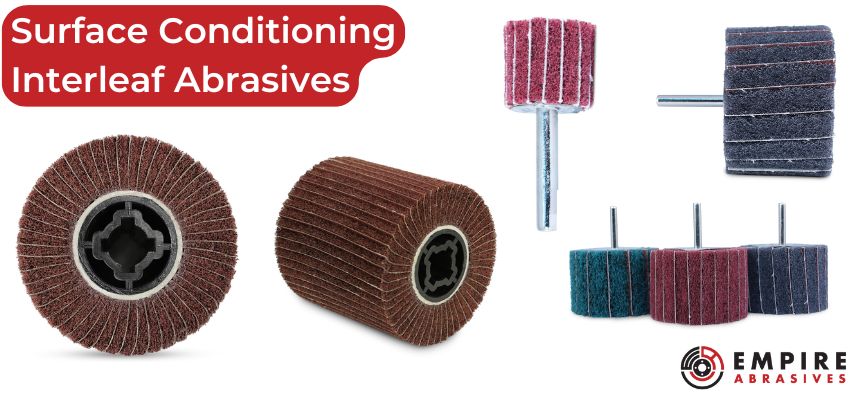
Sometimes you just want to kill two birds with one stone when it comes to using abrasive products. That's exactly what interleaf flap products were made for.
Types Include:
- Interleaf Flap Wheels: For die grinders.
- Interleaf Flap Wheel Drums: For tools like the Eastwood Surface Conditioning Tool (SCT).
How They Work:
These abrasives are constructed with flaps of sandpaper jutting out from the centerpiece of the tool, just as a typical flap wheel would. The difference with these is that the gaps are filled with the nylon surface conditioning material.
Applications:
- As the wheel or drum grinds against a metal surface, the abrasive flaps remove rust, paint, or body filler.
- Simultaneously, the Scotch-Brite™ material blends and smooths the surface, getting it ready for the next step in less time.
Surface Conditioning Drums
Surface conditioning finishing drums are your go-to solution when working on large, flat surfaces or curved surfaces like pipes and tubes. They're made from non-woven surface conditioning material wrapped around a cylindrical core and are designed for use with handheld drum sanders and specialized tools like the Eastwood SCT.
Applications:
- Surface Finishing: Ideal for creating uniform finishes on sheet metal and large workpieces.
- Rust and Paint Removal: Efficiently removes rust, paint, or other coatings from metal surfaces.
- Blending and Polishing: Smooths out imperfections and prepares surfaces for further finishing or coating.
Compatible Tools:
- Handheld Drum Sanders
- Burnishing Tools
- Contour Grinders
- Finishing Tools
- Surface Conditioning Tools
- Linear Grinders
- Eastwood SCT
Benefits Include:
- Efficiency: Covers large areas quickly, reducing the time spent on projects.
- Consistency: Provides a uniform finish across the entire surface.
- Versatility: Suitable for both flat and curved surfaces.
Why Choose Surface Conditioning Drums?
When working on large projects, such as metal fabrication for architectural elements or automotive restoration, surface conditioning drums can save you a significant amount of time. They allow you to achieve professional, consistent results without the fatigue that comes from using smaller abrasives over large areas.
Tackle large surfaces with ease. Check out our selection of non-woven surface conditioning drums for consistent results.
Unitized Wheels and Discs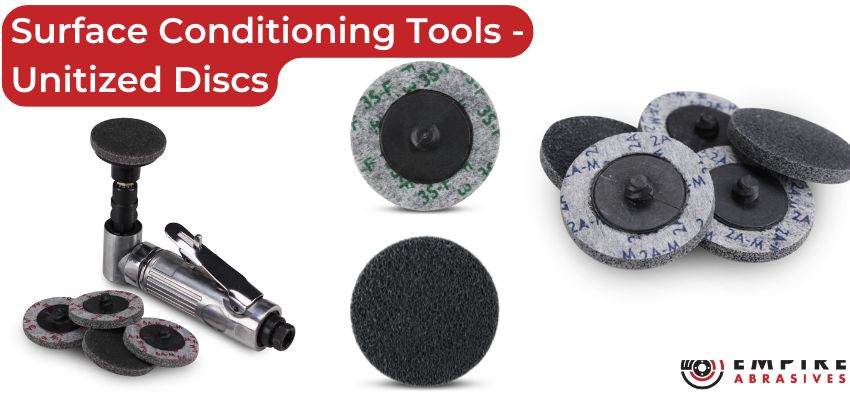
Unitized wheels and discs are precision tools crafted from compressed layers of non-woven nylon fibers impregnated with abrasive grains. They're designed for tasks that require a high degree of control and consistency without altering the part's geometry.
Applications:
- Polishing and Buffing: Achieve a high-quality finish on various metals.
- Edge Deburring: Perfect for removing sharp edges without changing the dimensions of the workpiece.
- Surface Blending: Ideal for blending machine marks or imperfections on metal surfaces.
Features:
- Compressed Non-Woven Material: Provides a dense, durable abrasive surface.
- Bi-Directional Use: Can be run in either direction, extending the disc's life.
- Reduced Loading and Heat Buildup: Keeps the workpiece cooler and prevents clogging.
- Extra Thick 1/4" Material: Offers longevity and consistent performance.
Available Options:
- Densities: Range from 2 (Low) to 8 (High).
- Low Density (2-4): More flexible, ideal for finishing flat, contoured, or irregular surfaces without damaging the part.
- High Density (6-8): More rigid, offering superior edge retention for heavy-duty applications.
- Abrasive Materials:
- Aluminum Oxide (A): Tough and economical, best for ferrous metals like soft steels and tool steels.
- Silicon Carbide (S): Fast-cutting, ideal for non-ferrous metals like stainless steel, titanium, and aluminum.
- Grades:
- Fine (F), Medium (M), Coarse (C): Choose based on the amount of material removal needed and the desired finish.
Why Choose Unitized Wheels and Discs?
When precision is key, unitized wheels and discs are unmatched. They allow you to perform delicate finishing tasks, such as removing small burrs or polishing intricate details, without compromising the integrity of the workpiece. Plus, their reduced loading and heat buildup extend the life of both the disc and your tool.
Looking for precision tools for polishing and blending? Explore our unitized discs today.
Surface Preparation Wheels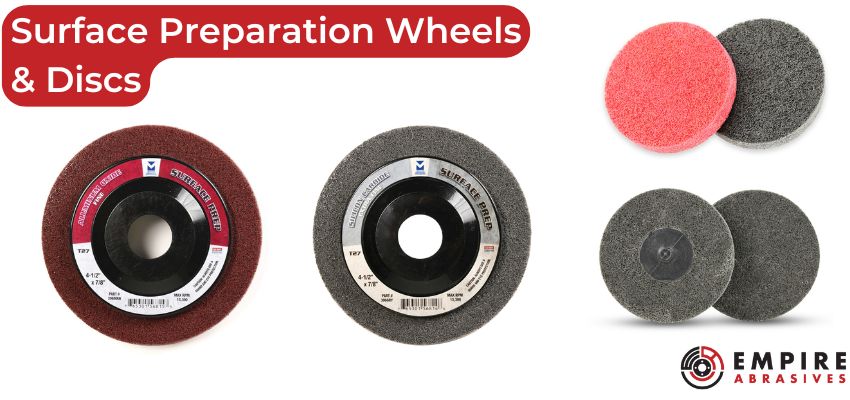
Surface preparation wheels are your go-to discs when you need to blend, finish, or clean metal surfaces, especially those discolored during welding or grinding. These wheels are made of densely packed non-woven synthetic fibers impregnated with aluminum oxide abrasive grains.
Applications:
- Blending: Smooth out welds or surface imperfections.
- Finishing: Prepare surfaces for painting or coating.
- Polishing and Cleaning: Remove discoloration, rust, or light surface contaminants.
Works Well On:
- Stainless Steel
- Standard or Alloyed Steel
- Non-Ferrous Metals and Alloys
Why Use Surface Preparation Wheels?
These wheels are perfect for those finishing touches that make your project stand out. They are used to create a uniform surface profile that helps you achieve optimal adhesion of paints, coatings, or adhesives.
Satin Surface Prep Airway Buffs
Satin surface prep airway buffs are specialized buffing wheels designed to create a satin or brushed finish on metals like stainless steel and aluminum, without the need of buffing compounds. They feature an open, pleated (airway) design with 4 ply of flexible, non-woven, nylon mesh fibers impregnated with abrasive grains.
Applications:
- Final Finishing: Achieve a consistent satin or brushed finish on your metal surfaces.
- Oxidation Removal: Excellent for cleaning and removing oxidation without harsh chemicals.
- Blending and Feathering: Smooth out surface imperfections and blend lines.
Key Features:
- No Compound Needed: The abrasive grains embedded in the buff do the work, simplifying the process.
- Airway Design: Allows air to flow through the pleats, keeping the workpiece cooler and preventing discoloration due to heat.
Benefits Include:
- Heat Reduction: Minimizes discoloration due to heat buildup.
- Consistent Finishes: Provides uniform results across the workpiece.
- Efficiency: Ideal for final finishing steps in metal fabrication.
Compatible Tools:
- Polishers / Buffers
- Angle Grinders (with appropriate attachments)
- Bench Grinders (with appropriate attachments).
Achieve a flawless satin finish without compounds. Shop our satin surface prep airway buffs now.
Types of Surface Conditioning Products (Table)
|
Product Type |
Primary Applications |
Compatible Tools |
|
Surface Conditioning Belts |
Blending, finishing, linishing, polishing |
Linishing machines, belt sanders |
|
Flap Discs |
Weld blending, finishing, polishing |
Angle grinders |
|
Hand Pads |
Cleaning, rust removal, light finishing |
Hand tools |
|
Hook and Loop Discs |
Blending, polishing, light grinding |
Orbital sanders, angle grinders |
|
Quick Change Discs |
Deburring, blending small areas |
Die grinders |
|
Interleaf Flap Wheels |
Rust removal, blending, smoothing |
Die grinders |
|
Surface Conditioning Drums |
Large surface finishing, rust removal |
Drum sanders |
|
Satin Surface Prep Buffs |
Satin finishes, oxidation removal |
Buffers, polishers, angle grinders |
How to Choose the Right Surface Conditioning Product
Based on Application:
- Deburring and Edge Refinement: Quick change discs, belts, unitized discs, or hand pads depending on the size of the workpiece.
- Blending Welds: Flap discs or interleaf wheels for seamless finishes. Surface preparation wheels for smoothing welds and removing discoloration.
- Surface Preparation: Hand pads, surface preparation wheels (as expected by the name), or hook and loop discs for cleaning and prepping surfaces.
- Polishing and Finishing Large Surfaces: Use finer grits and products like satin airway buffs or surface conditioning drums for desired finishes.
Based on Material:
- Stainless Steel: Use products that prevent contamination and maintain surface integrity.
- Aluminum: Select abrasives that prevent loading and minimize material removal.
- Carbon Steel: More aggressive abrasives can be used due to material toughness.
Grit Selection:
- Coarse Grits (Tan): For heavy material removal and rough surfaces.
- Medium Grits (Maroon): General-purpose blending and cleaning.
- Fine and Ultra-Fine Grits (Blue and Grey): Final finishing and polishing tasks.
Cost Considerations:
- Budget Constraints: Balance quality and cost for optimal value.
- Longevity vs. Price: Investing in higher-quality abrasives can save money over time due to extended life.
Compatibility with Coatings:
- Surface Finish Requirements: Some coatings require specific surface profiles for proper adhesion.
- Avoiding Contamination: Use non-ferrous abrasives on stainless steel to prevent rust contamination.
Not sure which product fits your needs? Contact our expert team or browse our product categories to find the right abrasive for your project.
Empire Abrasives Has You Covered
 Whether you’re tackling a DIY project or working in a professional fabrication shop, Empire Abrasives has the surface conditioning tools to meet your needs. From belts and discs to specialty tools, we offer high-quality abrasives at competitive prices.
Whether you’re tackling a DIY project or working in a professional fabrication shop, Empire Abrasives has the surface conditioning tools to meet your needs. From belts and discs to specialty tools, we offer high-quality abrasives at competitive prices.
Explore our full range of products on our website or reach out to our expert team for personalized advice. We’re here to help you achieve exceptional results.
Get Expert Assistance
If you're unsure which surface conditioning product is appropriate for your project or if you have any questions, please chat with one of our experts today. We're always happy to help our customers.
- Chat with Our Team: Find our chat on the bottom right corner of our website.
- Contact Us: Call us at 1-800-816-3824 or fill out our contact form for inquiries.
- Bulk Orders and Special Requests: We accommodate large orders and can assist with specialized product needs.
Additional Resources
- How Surface Conditioning Products are used in Metal Fabrication
- Your Ultimate Guide to Surface Conditioning Discs
- Troubleshooting Common Abrasive Tool Issues - Surface Conditioning Discs
- The Best Abrasive Tools for Sanding Curved Surfaces
- Surface Prepping a Car for Painting: Tools, Tips & Techniques for Automotive Painting Prep
- 7 Ways Abrasives Enhance Welding & Fabrication Part 2 Weld Grinding Cleaning Buffing & Surface Prep
- Scuff Pads vs. Sandpaper

